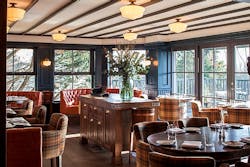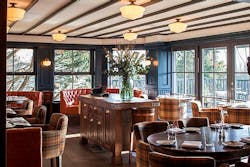The new Oxford Blue gastropub in Berkshire, UK has a chef that trained under Gordon Ramsay and architectural lighting design enabled by vintage-look filament lamps.
Fettle Design has delivered a new architectural lighting design in a new UK gastropub located near Windsor Great Park in Berkshire, relying on filament-style LED replacement lamps in both open fixtures and inside vintage globes. Chef and owner Steven Ellis, who trained under Gordon Ramsay, has converted two former gamekeepers’ cottages that date to the 1800s into a restaurant where the lighting design had to match the rustic setting. LED Eco Lights supplied the solid-state lighting (SSL) from its Bright Goods line to deliver warm CCTs and fully-dimmable capabilities.
Interested in articles & announcements on architectural lighting?
Restaurants have long been a challenge for lighting designers looking to use LED-based lighting. The technology has had great allure because energy efficiency is critical in reducing energy costs given the long operating hours of many restaurants. But many LED replacement lamps have lacked the warmth and dimming capabilities of halogen bulbs. Soraa has been the one company that has consistently found success with its lamps in restaurant settings, such as the London Hakkasan project announced 18 months ago. But lamp companies have improved product designs across the board, and the Bright Goods LED lamps apparently deliver both the light quality required and the vintage filament style.
The Oxford Blue gastropub achieves its rustic ambience with filament LED lamps from LED Eco Lights' Bright Goods line. (Source: William Pearce.)
“To create the intimate dining atmosphere we were looking for, the lighting had to be spot on,” said Andy Goodwin, director of Fettle Interior Design. “I was introduced to the Bright Goods range a couple of years ago and what is amazing about the bulbs themselves is that aesthetically they look beautiful and create the correct color light whilst still being energy efficient.”
Ultimately, Fettle specified three lamp families in the gastropub project. The 6W Catherine lamps have an A-lamp shape, and the 6W Jane lamps have a pear shape. Both have a sepia-tinted glass globe. The 3W Elizabeth candle lamps have a clear glass optic in the classic shape. All of the products feature efficacy at 100 lm/W, thereby delivering the desired energy savings. LED Eco Lights said all of the lines deliver a “timeless vintage feel,” and the dimmable products are specified to last for 30,000 hours, adding maintenance savings to the advantages associated with LEDs.
The chef and owner spoke to the results of the project. “We had a vision of creating an exceptional dining experience in the comfort of a traditional country style gastropub and wanted to make it as authentic as possible,” said Ellis. “We have created an atmosphere that looked like it had been there for hundreds of years rather than just created by us. Lighting is such an important factor when designing an interior and it was imperative that we got it right. The appearance of the Bright Goods LED lamps is exactly right for our concept, and furthermore, offers energy efficiency and low maintenance.”
Fettle Interior Design chose the filament LED lamps for their energy efficiency and dimmability as well as their ability to replicate the warm-white color of early incandescent lamps. (Source: William Pearce.)
And the designers are equally happy with the results. “The Bright Goods LED lamps have that element of traditional about them which was key to the overall concept we had for the restaurant,” said Goodwin. “The long lifespan of the lamps also means that maintenance becomes easier to manage. They were perfect for this setting, emitting a warm white color temperature that replicates the nostalgia of the early Edison incandescent models. Trying to play on the heritage of the building, we wanted the lighting in the restaurant space to be fully dimmable to keep the atmosphere as intimate and enticing as possible.”
We are certainly seeing more hospitality settings adopting SSL in the past few years as the technology has matured. For instance, we covered a notable hotel and restaurant project in Copenhagen, Denmark. Still, it will be interesting to see how many filament-style lamps meet the needs of the most demanding restaurateurs.







